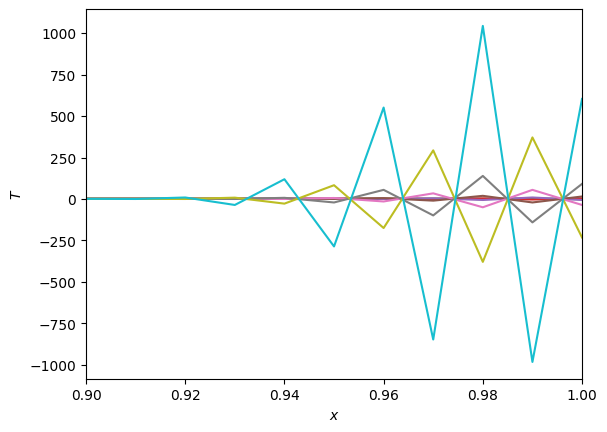Boundary conditions and numerical stability solutions#
Insulating boundary#
To implement an insulating boundary on the left, i.e. \(dT/dx=0\) at \(x=0\), we need to look at the update equation for the leftmost grid point at \(i=1\):
The temperature \(T_0\) is off the grid, so we need to use the boundary condition to determine its value. This is easy for the insulating boundary since \(dT/dx=0\) means that \(T_0 = T_1\). Therefore, the update equation for \(i=1\) is
This means that we need to modify the top left of the matrix so that the diagonal element is \(1+\alpha\) rather than \(1+2\alpha\).
import numpy as np
import matplotlib.pyplot as plt
import scipy.linalg
n = 1001
x = np.linspace(0, 1, n)
# Initial profile has T=1 everywhere except T=0 at the outer boundary
T = np.ones(n)
T[-1] = 0.0
plt.plot(x, T)
plt.xlabel(r'$x$')
plt.ylabel(r'$T$')
dx = x[1]-x[0]
dt = 1e-2
alpha = dt/dx**2
nsteps = 100
# Calculate the matrix A in banded form
b = (1 + 2*alpha) * np.ones(n)
b[0] = 1 + alpha #<========= New line to implement insulating boundary
a = -alpha * np.ones(n)
c = -alpha * np.ones(n)
c[-1] = 0.0
a[0] = 0.0
AA = np.row_stack((a,b,c))
# and the b vector (boundaries)
bvec = np.zeros(n)
#bvec[0] = 1 <===== Also we no longer need this since we are not fixing the value at the boundary
for i in range(1,nsteps):
T = scipy.linalg.solve_banded((1,1), AA, T + alpha*bvec)
plt.plot(x, T)
plt.show()

Numerical stability#
First we’ll do the von Neumann stability analysis for the implicit Euler update
Plug in
which gives
So we can see that \(|\xi|\leq 1\) for any choice of \(\alpha\), this method is always stable.
Next, let’s implement the explicit update and try an unstable timestep:
import numpy as np
import matplotlib.pyplot as plt
import scipy.linalg
n = 101
x = np.linspace(0, 1, n)
# Initial profile has T=1 everywhere except T=0 at the outer boundary
T = np.ones(n)
T[-1] = 0.0
plt.plot(x, T)
plt.xlabel(r'$x$')
plt.ylabel(r'$T$')
plt.xlim((0.9,1.0))
dx = x[1]-x[0]
alpha = 1.0
dt = alpha * dx**2
nsteps = 10
# Calculate the matrix A for the explicit update
b = (1 - 2*alpha) * np.ones(n)
b[0] = (1 - alpha)
a = alpha * np.ones(n-1)
AA = np.diag(b) + np.diag(a,k=-1) + np.diag(a,k=+1)
for i in range(1,nsteps):
T = AA@T
plt.plot(x, T)
plt.show()

If you run this with \(\alpha\leq 1/2\) it will be stable and give the same solution as before, although a lot more slowly. Above we’ve taken \(\alpha=1\) and zoomed in on the right hand part of the grid. We see that the unstable mode is such that alternate grid points move in opposite directions: the wavelength is twice the grid spacing as predicted by our stability analysis.
